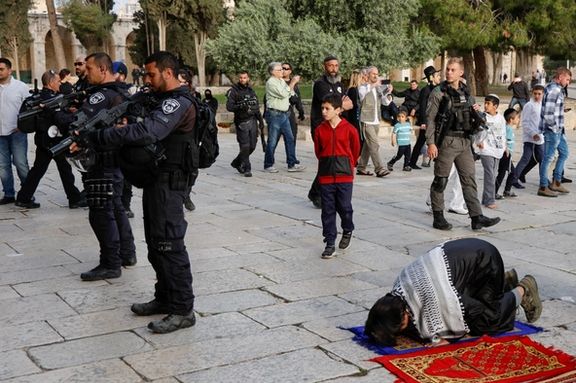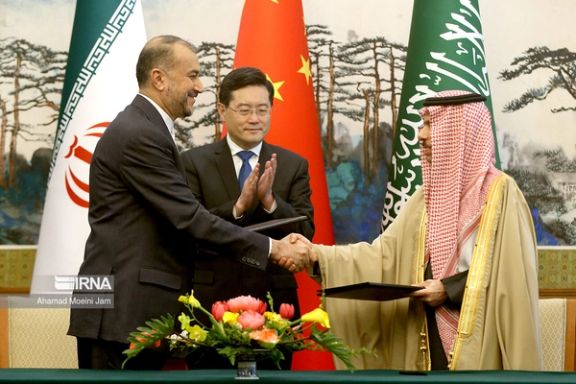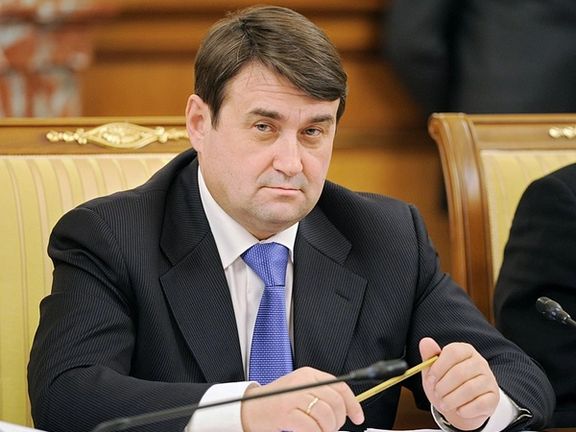Iran, Azerbaijan FMs Hold Phone Call To Prevent Escalation

Crisis talks between Baku and Tehran have continued over the weekend in a bid to reduce rising tensions between the two nations.

Crisis talks between Baku and Tehran have continued over the weekend in a bid to reduce rising tensions between the two nations.
Foreign Minister Hossein Amir-Abdollahian told his counterpart Jeyhun Bayramov of the “necessity of Islamic solidarity between Iran and Azerbaijan against Israel”, Iran’s nemesis.
The two had frank discussions about what the state news agency, IRNA, termed the “existing misunderstandings” as both sides urged de-escalation.
It has been a tense few months between the two states. Iran angrily reacted to Azerbaijan’s opening an embassy in Tel Aviv in March, in addition to relations souring following an armed attack on Azerbaijan’s embassy in Tehran in January.
Just last week, Azerbaijan expelled four Iranian diplomats over “provocative actions” which have yet to become clear, with Iran promising to do the same in return. Six Azerbaijanis were arrested hours earlier accused of a Shi’ite coup plot, believed to have been led by Tehran.
This weekend, the spokesperson of the Ministry of Foreign Affairs of Azerbaijan, Aykhan Hajizada, rebutted the pressure from Tehran, asserting that Islamic solidarity does not mean interfering in the internal affairs of other countries nor supporting the occupation of Muslim countries' lands.
In a bid to drive a wedge between Azerbaijan and Israel, the spokesman of Iran's Foreign Ministry, Nasser Kanaani, called on Azerbaijan to show Islamic solidarity against Israel and the recent events in Al-Aqsa Mosque.
Refusing to take the bait, Hajizada highlighted what it sees as Iranian hypocrisy: "The claim of Islamic solidarity by Iran comes as it did not protest against the occupation of the lands of the Republic of Azerbaijan by Armenia for 30 years."

Chaos at the hands of Iran’s allies and proxies rippled across the region this weekend, with its effects felt from Israel to the US with Israel blaming Tehran.
Last Thursday saw the worst rocket attacks launched on Israel from Lebanon’s south in the most intense flare-up since 2006, at the same time as rocket attacks were being launched from Hamas-controlled Gaza in Israel’s south.
On Saturday night, that front extended to Syria, where rockets were fired into the Golan Heights. In both cases, Israel has strategically but moderately responded, attacking the likes of rocket launchers, radar and artillery positions in the wake of the attacks.
The turbulence continued after the announcement that the US Navy has deployed a guided-missile submarine capable of carrying up to 154 Tomahawk missiles to the Middle East in a show of force toward Iran following recent tensions. Just last month the US launched airstrikes against Iran-backed forces in Syria after a rocket attack killed a US contractor and wounded seven other Americans in that country’s northeast.
The latest deployment is believed to follow the uncovering of a plot by Iran’s Revolutionary Guards Aerospace Force which was preparing a drone attack against Israeli-owned civilian merchant vessels sailing in the Persian Gulf and the Arabian Sea, according to a report in The New York Times.
In a rare acknowledgment of the location and deployment of submarines, Commander Timothy Hawkins, a spokesman for the 5th Fleet based in Bahrain, said it can carry up to 154 Tomahawk land-attack cruise missiles and is deployed to US 5th Fleet “to help ensure regional maritime security and stability”.

]The 5th Fleet patrols the crucial Strait of Hormuz, the narrow mouth of the Persian Gulf through which 20% of all oil transits. Its region includes the Bab el-Mandeb Strait off Yemen and the Red Sea stretching up to the Suez Canal, the Egyptian waterway linking the Mideast to the Mediterranean Sea.
The US, UK and Israel have accused Iran of targeting oil tankers and commercial ships in recent years, allegations denied by Tehran. The US Navy has also reported a series of tense encounters at sea with Iranian forces that it said were being recklessly aggressive.
And now, many are waiting to see what Israel’s bigger response will be to the attacks from Lebanon, which at minimum, have the tacit approval of Hezbollah which controls the area, but no doubt, has the blessing of Tehran.
So far, Israel has cautiously attributed blame to Palestinian factions in Lebanon, compounded by the fact Hamas’ political chief, Ismail Haniyeh, had met with Hezbollah leader Hassan Nasrallah on the eve of the rocket barrage.
The Israel Defense Forces’ spokesman alluded to the fact that investigations into Iranian involvement were underway in a press briefing Thursday but this weekend, Israel’s Minister of Defense Yoav Gallant spoke with his US counterpart, Secretary of Defense Lloyd Austin, and for the first time, claimed the attacks from both Gaza and Lebanon, were done "with the backing of Iran”.
While Hamas continues its campaign of chaos, the prospects for calm look slim. Carefully orchestrated riots inside the world’s third holiest Muslim site, Al Aqsa Mosque in Jerusalem, provoke often violent responses from Israel Police, appointed to safeguard freedom of worship.
Images of masked rioters in physical confrontations with police inside the mosque continue to stir the hatred and fuel Iran’s strategy for weakening Israel’s image in the public eye.
The Iranian regime’s media is boasting of its proxies destabilizing Israel and intimidating “the Zionists”.
On Sunday, Mohammad Baqer Qalibaf, speaker of Islamic Republic’s parliament, spoke in the public session of the legislative body and called Israeli retaliation “barbaric attacks”.
He left little to the imagination about the regime’s future plans. The multi-faceted war against Israel continues unabated. He warned: “The Zionist regime is in its weakest state in history and knows that a harsh and crushing punishment awaits them.”

Three prominent actresses defiantly appeared ‘bare headed’ at the funeral of a colleague Friday despite authorities’ warnings of serious consequences for ‘hijabless’ women.
Katayoun Riahi, Golab Adineh, and Fatemeh Motamed-Aria attended the funeral of popular film director, Kiumars Pourahmad in Tehran, who tragically ended his own life earlier this week.
Angered by such open defiance, hardliners on social media are calling for their punishment to set an example for others while taking their cue from Supreme Leader Ali Khamenei’s speech earlier this week. Officials, lawmakers and regime clerics are vowing to re-impose the hijab rules that women have increasingly been defying in the past six months.
“Start from celebrities, not the hijabless girls on the street because these celebrities are their role models,” a hijab promoter said in a Twitter post with the ‘hijabless’ images of Riahi and Adineh at the funeral.
Riahi, 61, was the first among Iranian female artists to express her solidarity with the Mahsa Movement amidst the nationwide protests in September by sharing her photo without a veil on Instagram. “Iranian women are each other’s voices,” she said in her post.
A man wearing a shawl over his head at a protest rally outside the National Library
The award-winning actress fled in time to avoid being arrested by security forces who raided her house but was arrested in November after living in hiding for two months.
Riahi was subjected to huge phycological pressure during her trial in December to “apologize’ for her deed but had to be taken to hospital from the court after fainting and losing her consciousness in front of the cameras filming the proceedings, apparently for airing on the state television.
Kazem Sadighi, head of the regime’s chastity outfit, the headquarters for Promoting Virtue and Preventing Vice, said Saturday that the “hijab criteria” drawn up by his organization has been sent to the president, parliament and the judiciary and that it will be communicated to government offices to enforce after being finalized.
Katayoun Riahi telling Iran International TV in November that she had never believed in hijab to “remove” it now.
In their sermons this Friday, the ultra-hardliner Friday imam of the religious city of Mashhad, Ahmad Alamolholda, threatened again that “people” may take the matter into their own hands against women who defy the hijab if authorities did not “have plans” to deal with “hijablessness”.
Katayoun Riahi telling Iran International TV in November that she had never believed in hijab to “remove” it now.
Khamenei and other officials including Chief Justice Gholam-Hossein Mohseni Ejei have repeatedly accused those opposed to compulsory hijab of working for “enemy” intelligence services.
At a meeting with state officials Tuesday, Khamenei claimed that foreign intelligence services were encouraging Iranian women to disobey mandatory hijab. He also claimed that “the enemy” is working according to “a plan and plot” and urged authorities to have their own plan for dealing with the issue of hijablessness.
While claiming that most Iranians agree with enforcing compulsory hijab, Ejei’s deputy, Mohammad Mosaddegh, repeated Khamenei’s accusations Thursday and said the judiciary will “take serious action” against “hostile” individuals who are “cooperating with foreign intelligence services to promote hijablessness”.
The police in several cities including Tehran have been summoning women whose ‘hijabless’ images were picked up by CCTV cameras. The police have also asked citizens to report the plate numbers of cars in which passengers are ‘hijabless’ and threatened to punish them “in accordance with the law”.
The measure has backfired and caused chaos in the system as many citizens have reported the plate numbers of cars whose passengers wore hijab, particularly the long black veil known as chador that the regime has always promoted as the measure of excellence in hijab abidance.
On Friday a small group of male and female members of the National Library protested outside the library against the decision to cancel the membership of ‘hijabless’ women.
Men who had participated in the rally wore headscarves in protest to compulsory hijab and after chanting “Woman, Life, Freedom” women threw their headcovers into a fountain.

Hardliner lawmakers dominating Iran’s parliament amid multiple crises are looking for ways to ensure their re-election, including tampering with electoral law.
The semi-official news agency ISNA reported April 6 that a parliamentary committee has suggested that no one who has already served as a lawmaker for three rounds in the parliament (Majles) should be allowed to run in the next parliamentary election in March 2024. The proposal is not to bar those who have served consecutive terms, but anyone who has served three terms.
Many of the ultra-conservatives in the current Majles are first term lawmakers, while there are many prominent and more moderate politicians who can challenge them next year.
Social media users in Iran noted that that the motion is a way of barring individuals such as former President Hassan Rouhani and former Majlis Speaker Ali Larijani from running for the next round of the parliament.

This is presumably meant to save the embarrassment of disqualifying high-profile candidates ahead of the upcoming election, social media activists said.
In the 2020, the Guardian Council packed with loyalists of the Supreme Leader Ali Khamenei, disqualified hundreds of ‘reformists’, allowing the hardliners to breeze through in a low-turnout election. But the mass rejections became a serious embarrassment for the regime and after months of protests, Khamenei would prefer to bar unwanted politicians in a less direct manner.
According to ISNA, the suggestion has been made by the internal affairs committee of the Majles as part of the proposed amendment to the election law. However, the deputy speaker should review the suggestion to make sure it does not contradict the current laws before sending it for debate in an open session.
If the suggestion is discussed and approved by the Majles, then the constitutional watchdog Guardian Council has two weeks to accept or reject it. However, it is a known fact in Iran that the council operates based on Khamenei's preferences rather than the law.
Reformist daily Shargh wrote on the same date that others including former Vice President Es'haq Jahangiri and former lawmaker Ali Motahari will also be barred from running for the next Majles if the suggestion is approved.
According to Shargh, if accepted, the move will provide a stronger guarantee for the current ultraconservative "young revolutionary" lawmakers' re-election. In a similar move, the ultraconservatives raised the minimum age for presidential candidacy so that former IT Minister Mohammad Javad Azari Jahromi would not be able to run for President in 2021.

Shargh's columnist Vahideh Karimi wrote that as far as the young lawmakers of the current Majles are concerned, the ratification of this suggestion is a fateful event for them. They know that individuals such as Ali Larijani or Motahari can quickly form a strong alliance once they are elected, and this will make it hard for the remaining ultraconservatives at the Majles to exercise influence.
The move will also bar some of the conservative members of the parliament such as Mostafa Mirsalim from running in 2024 but the ultraconservatives cannot be less concerned as Mirsalim and other elderly and experienced traditional conservatives are less popular than the moderates who might wish to make a comeback.
In the meantime, the poor performance of the current parliament has left very little hope for most current lawmakers' re-election. As a Khabar Online report noted earlier, hardliners in Majles have done little in three years, except trying to pass laws to restrict freedoms.
Meanwhile, according to a Tasnim news agency report, Majles Speaker Mohammad Bagher Ghalibaf has called for boosting the people's trust in the government to ensure a higher turnout in the next election. Last time, less than 20 percent of potential voters took part in Tehran and around 40 percent in small towns and villages. "Without this trust, everyone will lose, and the people will trust us only if we share decision-making with them," said Ghalibaf.

Saudi news media say officials have arrived in Iran to discuss procedures for reopening Riyadh's embassy in Tehran and consulate in Mashhad.
Saudi Press Agency (SPA) reported that a technical team tasked with discussing mechanisms for reopening the Kingdom’s embassy in the Islamic Republic of Iran arrived in capital Tehran Saturday.
“The Saudi technical team, headed by Nasser bin Awad Al-Ghannoum, met with the Chief of Protocols at the Iranian Ministry of Foreign Affairs, Mehdi Honardoust,” added SPA.
This is the first visit of a Saudi delegation to Iran after China brokered a deal to restore relations between the two regional powers. Relations were severed in January 2016 following attacks by Iranian mobs on Saudi diplomatic missions.
However, Iran’s foreign ministry has not yet published any news about the visit at the time of writing this report.
On Thursday, the foreign ministers of Iran and Saudi Arabia met in Beijing for the first formal meeting in more than seven years.
After years of hostility that fueled conflicts across the Middle East, Iran and Saudi Arabia agreed to end their diplomatic rift and reopen their diplomatic missions in March.
Chinese President Xi Jinping helped broker the surprise deal which left the United States on the sidelines.

Iranian media report that the special assistant of the Russian president will hold talks with Iran's national security chief Ali Shamkhani on Sunday.
According to IRNA state news agency, Igor Levitin, who arrived in Tehran Friday night, will meet secretary of Iran's Supreme National Security Council on Sunday.
During Levitin's visit to Iran last January, the two countries agreed that the remaining part of the North-South strategic corridor, in Iran’s northern Rasht-Astara route, will be built with the direct investment of Russia.
IRNA, also added that the two sides will review the process of implementing joint economic projects, especially speeding up the implementation of the North-South Corridor.
Meanwhile, Russia’s Sputnik reported that Levitin was scheduled to meet with First Vice President Mohammad Mokhber and Minister of Roads and Urban Development, Mehrdad Bazrpash on Saturday.
The International North-South Transport Corridor (INSTC) is a 7,200-km-long multi-mode network of ship, rail, and road route for moving freight between India, Iran, Azerbaijan, Russia, Central Asia and Europe.
The objective of the corridor is to increase trade connectivity between major cities such as Mumbai, Moscow, Tehran, Baku, Bandar Abbas, Astrakhan, etc.
Russia, Iran and India signed the agreement for the NSTC project in 2002. All three countries are founding member states on the project. Other important member states include Azerbaijan, Armenia, Kazakhstan and Belarus with other states having varying levels of involvement.
Iran started construction work to complete the missing link of the Qazvin-Rasht-Astara road and railway in 2017.